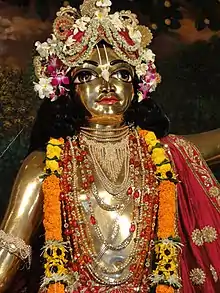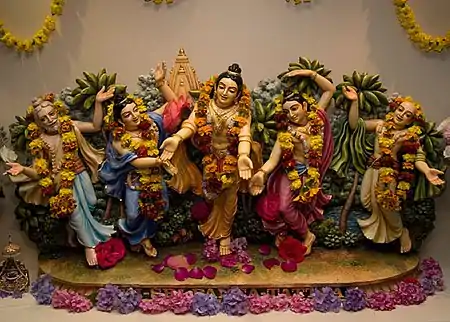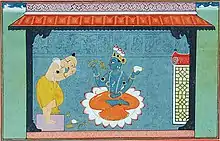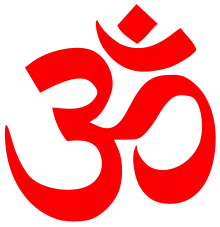Śrī Gadadhāra Pandita | |
|---|---|
 Deity of Śrī Gadadhāra Pandita, ISKCON Mayapur | |
| Personal | |
| Religion | Hinduism |
| Known for | Expounded Gaudiya Vaishnavism, Bhakti yoga along with Śrī Kṛṣṇa Caitanya Mahaprabhu and Śrī Nityānānda Prabhu |
| Other names | Gadādhar Bhaṭṭ,[1] Gadai |
| Philosophy | Bhakti yoga, Achintya Bheda Abheda |
| Religious career | |
| Guru | Madhavendra Puri (mantra guru) |
| Reincarnation | Krishna's internal energy |
| Associates | Śrī Advaita Ācārya, Śrī Kṛṣṇa Caitanya Mahaprabhu, Śrī Nityānānda Prabhu, Śrīvāsa Thakura, Haridasa Thakur, Ramananda Raya and others |

| Part of a series on |
| Vaishnavism |
|---|
 |
| Part of a series on | |
| Hindu philosophy | |
|---|---|
 | |
| Orthodox | |
|
|
|
| Heterodox | |
|
|
|
Gadadhara Pandita, also known as Pandita Goswami, was a close childhood friend of Chaitanya Mahaprabhu.[2] Gadadhara Pandita Goswami is described as a handsome young boy, student of Nyaya (Indian logic) and ranked highest among the inner circle of Chaitanya Mahaprabhu's followers.[3]
In the later part of his life, Gadadhara Pandita lived in the Tota Gopinatha Temple.[4] The local legend around the temple is that the deity of Krishna in the temple sat down to accommodate Pandit Goswami's worship might not be so correct. Gadadhar did not survive long after Chaitanya therefore he was not old and feeble. Some say that Chaitanya Mahaprabhu and Pandit Goswami disappeared on the same day inside the Gundicha Temple of Puri, Odisha. Devotees of Gadadhar would assemble at Govinda temple in Vrindavan. The Govinda deity was installed by Rupa Goswami a disciple of Gadadhar Pandit Goswami. The temple head priest was one Radha Krishna Goswami in the lineage of Gadadhar who wrote in the Sadhana Dipika that Gadadhar Pandit was Radha, and he also wrote many praises to Rupa Goswami in that book. Gadadhar Pandit spent his later life in Orissa serving Tota Gopinath. Chaitanya lived a mile away during that time, at the Gambhira. He used to come to hear Gadadhar Pandit speak on Krishna while Gadadhar’s eyes would rain tears. The first Radha deity installed in Vrindavan was sent by Gadadhar Pandit. The parakiya worship of Radha started from that time. [5]
The Gadadhara Parivara
Chaitanya Mahaprabhu personally gave Gadadhara Pandita Goswami the deity to worship, and the responsibility to teach Srimad Bhagavatam.[6] Pandita Goswami's guru was Pundarika Vidyanidhi. Pandita Goswami initiated Bhugarbha Goswami, and Bhugarbha Goswami gave rise to one line of the Gadadhara parivara. The Gadadhara Parivāra (Parivāra means 'family') is one among different traditional Chaitanya lineages that have continued till modern times;[7] the Advaita Parivāra is another example.
Because Pandita Goswami is considered to be Laksmi or Radha the followers of Pandita Goswami come directly under her .[8] The custom of the Gadadhara parivara is to worship the deities of Gaura and Gadadhara.
Followers of the Gadadhara parivara are of the opinion that Rupa and Sanatana Goswami, Narottama Dasa Thakura Mahasaya and his guru Lokanath Goswami were disciples of Gadadhara Pandita.[9] Others hold that Sanatana Goswami was the disciple of Madhusudana Vidyavacaspati, the brother of the famous logician Sarvabhauma Bhattacarya, and Rupa Goswami was the disciple of Sanatana Goswami. Again there are others, that are saying that Sanatana Gosvami was the disciple of Chaitanya Mahaprabhu.
See also
References
- ↑ "Gadadhar Bhatt and His Family".
- ↑ De, Sushil K. (1942). Early History of the Vaishnava Faith and Movement in Bengal. p. 254.
- ↑ Kapoor, O.B.L. (1976). The Philosophy and Religion of Sri Caitanya. p. 23.
- ↑ "Tota Gopinatha temple". www.jagannathpuri.in. Retrieved November 1, 2017.
- ↑ Das, Vrindaban. Shri Chaitanya Bhagawat, Publication=Reflect Publication, Kolkata.
- ↑ Shastri, Haridas (2015). Sri Guru Darsanam. Vrindavan: Shri Haridas Shastri Goseva Sansthan. p. 283. ISBN 978-81-929328-0-4.
- ↑ "Our Guru Shishya parampara". sriharidasniwas.org. Retrieved November 1, 2017.
- ↑ "Worship of Sri Sri Gaura Gadadhara". jiva.org. Retrieved November 1, 2017.
- ↑ "Sri Gadadhara Pandita's Role in the Gaudiya Sampradaya". jiva.org. 10 March 2013. Retrieved November 1, 2017.